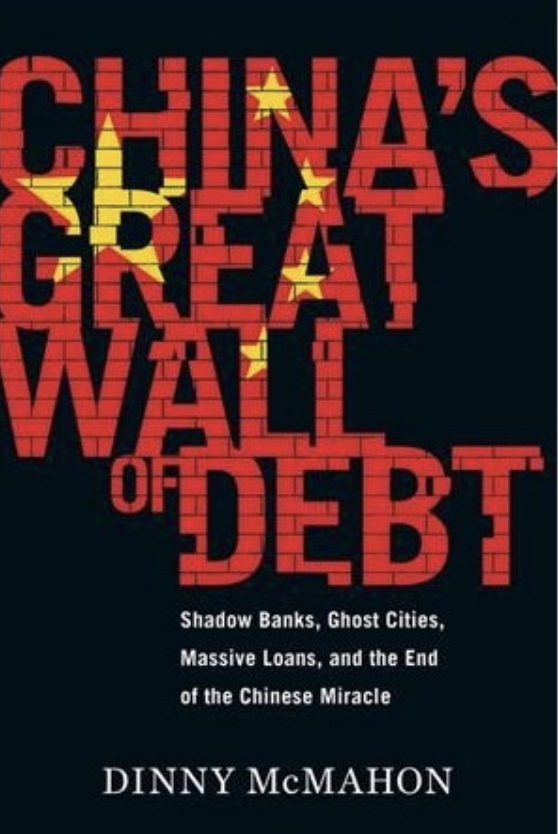
Dinny McMahon
Houghton Mifflin Harcourt (March 13, 2018)
288 pages
What’s it about?
China’s Great Wall of Debt takes both a bird’s-eye and street-corner look at what is undoubtedly the global economy’s most vexing question. In its pursuit of an unending cycle of annual economic gains, infrastructure rollout and technological catchup, just how much debt has China accumulated in the course of its red-hot stimulus frenzy since the Great Financial Crisis of 2008? Does the middle-income trap and the opacity of the system—even for the “helmsmen” in Beijing—condemn China to continual Band-Aid fixes that eventually result in an economic implosion with global consequences?
One answer, according to McMahon, is that a crisis is likely, but the interconnected complexity of the system is such that it’s difficult to assess how bad it might be. “As an old Chinese adage has it,” writes McMahon, “‘Numbers make officials, so officials make up numbers.’” He quotes another adage: “Villages lie to townships, townships lie to the counties, and so on all the way to the State Council.” Such adages are well known beyond even the Great Wall of China, and they do not necessarily signal the end of the “China Miracle,” as McMahon’s subtitle suggests.
Especially when you consider it has been a miraculous hell of a run, however it all turns out.
But McMahon has many important ports of call, even if we’ve touched shore at most of them before—construction of ghost towns reaching “plague proportions,” ghost-town mayors doubling down on investment, with—amid many absurd examples—plans for Christianity theme parks and artificial surfing pools in cities where everything freezes over for four months of the year; the cyclical absolution for financial waste as the Party-official architects of roads to nowhere and cities for no one are recycled upwards and onwards in the political system—or are randomly jailed for corruption in a system defined by corruption.
This is a top-down system in which officials, writes McMahon, “can borrow without having to worry about being responsible for repaying the debt … [and] use new cities to burnish their credentials.”
So far, China has handled this and so much more. “Perhaps the biggest risk is that Beijing itself will do something that inadvertently results in a financial crisis,” the author writes. “It could be completely unforeseeable, like an anticorruption campaign resulting in revelations of widespread financial fraud. Or perhaps pressure on the currency to depreciate might lead Beijing to devalue the yuan, a situation which, if mishandled, could exacerbate depreciation pressures and cause the public to pull their savings from the financial system and try to move it overseas.”
This is a book awash with minutiae and macro-data that elucidates why the Chinese economy is simultaneously absurd, prone to incite awe, and opaque to understanding—and to the kind of change it needs—even for those “running” it. China’s Great Wall of Debt may be, as some critics have argued, overreaching in its ambition and too wide-ranging, but the subject itself deserves no less.
Takeaway quotes
“Crony capitalism, state capitalism, and free-market capitalism all fail—both individually and in the aggregate—to sufficiently describe the nature of the Chinese economy.
“China has been able to post such outstanding economic growth in recent years not because of the guiding hand of the central government but in spite of it … [and meanwhile] both safety and long-term stability have been sacrificed in the interests of short-term growth.
“With great discretion to do as they see fit, and with ready access to credit from the banks, managers at state firms find that the easiest way to grow their companies is to simply borrow more and build more. The result is that a massive amount of debt has been accumulated and wasted by building factories that no one needs.
“Building new cities—and adding entire new ‘districts’ to the outskirts of existing cities—has become business as usual in China … Many new cities and new districts—a jumble of central business districts, resort strips, ecocities, and administrative zones—were being built to house populations ‘basically equal’ in size to the original cities they were attached to.
“In 2013, plans for new cities and new districts were sufficient to house about 3.4 billion people, more than twice China’s total population.
“China has built the world’s biggest high-speed railway network, and new highways crisscross the nation. The world’s top architects flock to China to realize their most creative impulses on government-sponsored opera houses, libraries, and office buildings. Yet the perception that China has managed to do all this without financial constraint is a serious illusion.
“Since 2008 … the amount of new money that China has created … has dwarfed all three of the major industrial economies combined. Between 2007 and 2015, China was responsible for 63% of all new money created globally.” [Commercial banks and the creation of money is an argument best left for elsewhere.]
“At the end of 2014, the amount of credit that had been generated by the shadow-banking system was about 40% the size of China’s GDP. By mid-2016, that had doubled, to about 80%.
“Slower growth is starting to expose a multitude of sins. When an economy is expanding in size by 10% every year, middling managers become successful businesspeople, and hustlers turn into feted entrepreneurs. Loans that can’t be repaid at a slower pace of economic expansion aren’t a problem when the economy is booming. Companies can always just grow through their mistakes. Slower growth exposes the waste, mismanagement, hubris, and fraud that remained hidden during the good times.
Key points
The tax dilemma: Local governments, claims McMahon, are responsible for around 80 percent of expenditures, but Beijing takes 50 percent, leaving a shortfall that leads to “creative” methods to spur local growth and generate tax revenues—often employing “destructive and exploitive measures to achieve their targets, without concern for the consequences.”
The shuffle effect: Beijing has been effective at shuffling bad debt, and may yet avoid an economic meltdown, but local governments still face the risk of being unable to continue wasteful buildout projects that are the basis of growth.
Land for sale: Technically all land is state owned, but in 1988 the constitution was altered to allow developers to buy and sell land under long-term leases (70 years for residentially zoned land and 50 years for industrial). This superficially maintains the illusion that all land is still owned by “the people,” but has allowed the government to turn land into cash for finance China’s march to modernity.
Land up for grabs: Local governments too often see “land finance as though it’s free money,” building without reference to demand or consequences, and, writes McMahon, it has become an addiction. “In 2014 alone, local governments raised thirty-one times more money from land sales than they did in 2001.”
Human consequences: Ordinary Chinese are often inadequately compensated for land grabs, or not compensated at all, with developers sometimes teaming up “with thugs to intimidate farmers into submission. Farmers have woken to find that their land had been salted and would no longer grow anything.”
The land bubble: The average building in China has a lifespan of 20 years due to poor construction, making the value of housing the land it’s built on. It is land that drives housing prices, making land too expensive to make money on apartments, leading developers to speculatively count on the government to encourage ever more lending.
The debt machine: As McMahon puts it, “Beijing’s tolerance has unleashed a perpetual-motion machine of debt creation over which it has seemingly lost all control.” Banking regulations are such that the more banks lend, the more money they make, leading China’s former chief economist and spokesman of China’s National Bureau of Statistics to describe the banking system as a highway toll system.
Enter shadow banking: P2P lending and wealth management products (WMPs) are so opaque that Beijing has no idea how much debt is being created, but by 2016 shadow-banking created debt was thought to account for 80 percent of GDP.
Demographics: China is getting older than anywhere else in the world, largely due to its one-child policy, introduced in 1979, and only recently phased out—and probably too late. China, unlike Japan, will likely grow old before it grows rich, resulting in pressure on state resources for healthcare, reduced demand for everything from apartments to smartphones, and pressure to raise wages as employers are compelled to pay more to simply secure staff.





